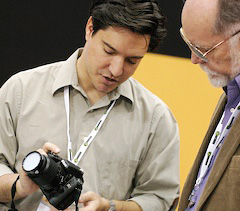
As good as our camera's built-in reflective meter is, some high-contrast situations can fool them. For many years, handheld incident meters were used by serious shooters to ensure proper exposure in difficult lighting. You can use your ExpoDisc to convert your camera's reflective meter to incident by following these easy steps.
- Set your camera to Aperture Priority mode and choose an f-stop, such as f-5.6.
- Put the ExpoDisc on your lens.
- Turn off autofocus mode.
- Point your camera in the direction of the light source illuminating your subject and click the shutter. The trick here is to meter the same light that is falling on your subject. Review the grayscale image created by the ExpoDisc in your camera's LCD monitor. Note the shutter speed recorded at exposure. That combination of shutter speed readout and the f-stop you set is the "incident" reading for that scene.
- Return your camera to autofocus mode, set the aperture/shutter speed combination you recorded (manual exposure mode is probably easiest for this) and shoot the scene.
The difference between a reflective meter reading and incident is that reflective measures the light bouncing off the subject, and incident records the light falling on the subject. Since your camera's meter is calibrated for 18 percent gray, as is the ExpoDisc, you can convert your reflective meter to incident by using this method. (You can read more about incident meter reading in this brief Luminous-Landscape tutorial.)
If you want to take advantage of this technique to the fullest, the ExpoDisc manual includes more information on how to meter for incident light under different lighting conditions (Section 2.d). One additional tip, for instance, is that, when shooting a backlit subject, you can reduce the exposure one full stop to preserve darker than normal tones in shadow areas.
As an added bonus, remember that you can set the custom white balance at the same time you take the incident meter reading, ensuring that you have both accurate color and exposure. Give it a try!
Photo of John Baker demoing ExpoDisc at Photoshop World, Boston by Derrick Story.
Technorati Tags: technique, The Digital Story

Join Derrick Story for a Digital
Photography Field Trip in Orlando Florida on May 11. And don't
miss his sessions on Camera
Raw and Photoshop
Lightroom. CRE8 Conference - May 9-11, 2007












Derrick,
Another great post. Can you give us any specific examples of high contrast situations in which you think it is better to use an incident rather than a reflective measurement for exposure determination?
Thank you,
Kevin
Speaking of White Balance, Sunday I was at the Kauai All Girls Rodeo and struck up a conversation who also had a camera. She told me shoots with the white balance setting to something other than Auto, Sunday she had it set to cloudy. She said she is able to adjust all of her photos in Photoshop at the same time. Derrick, what do you think?
John